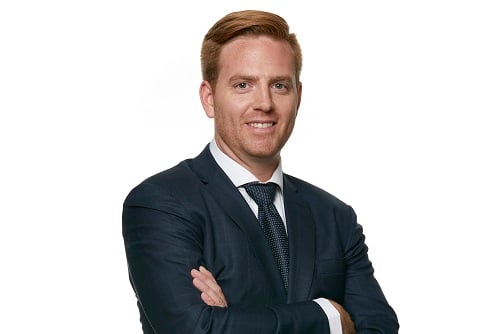For Simon Partington, hard work, consistency, and a long-term focus are crucial to success

When you speak with Simon Partington, you can’t help but detect an aura of enthusiasm. He talks like someone who knows and has gotten exactly what he wanted as a career – and that’s because it’s true.
“I have always been interested in how companies are built, how they earn profits and how they can become more efficient and hence more profitable,” said Partington, director of wealth management and portfolio manager of Partington Wealth Management at Richardson GMP. While he always enjoyed math, it wasn’t until his university years that he could combine it with his passion for business. And when he later had to decide between investment banking and wealth management, the choice was clear.
“I really enjoy people, helping them and learning about their families or success stories in business and then working to help them build on and protect the wealth they have created,” he said. “Not everyone needs to have built a great company or be a multi-millionaire to achieve financial freedom. You just need to spend less than you earn and learn how to budget and save.”
A lot of people get up in the morning thinking of what they’ve got to do. But Partington gets up thinking of what he gets to do: see his business grow along with his clients’ portfolios, and help new clients who are seeking professional advice — and are referred to his practice.
“We work with about 150 households, and the majority of them are telling other friends about the level of service and how happy they are,” he said. “Building trust with clients is a very important process that takes time. Once a client sees the level of service and due diligence we put into customizing their strategy, they are very appreciative.”
Partington’s secret to success has been a focus on hard work, consistency, and improvement. On the business side, he applies this by building more efficient processes and better client service experiences. Professionally, he uses best practices and regularly takes courses to stay on top of the markets and industry changes.
“For me, the most useful designations have been the CFP and also the CIM,” Partington said. “My Certified Financial Planning gives me the wealth of knowledge to handle the issues that come up such as clients going through a divorce or clients setting up a financial plan to reach their goals. As a Chartered Investment Manager, I’m able to create synergies and scalable strategies, which include running a model stock portfolio on a discretionary basis. It really frees up the time for me to sit down with all of the clients, learn what their needs are, and how I can help them out along the way.”
At Partington Wealth Management, they have model portfolios that focus on asset allocation to meet individual client needs and risk profiles. While Partington acknowledges the industry trend of investors paying lower fees, it can be at the cost of advice or even active management. It’s achievable, he says, given high correlations between traditional markets that have been rebounding off 2009’s recession. However, he stresses the importance of adding alternatives that can provide upside when markets fail.
“As a portfolio manager, my goal is to invest a client’s portfolio into different asset classes that move at different times to provide overall steady returns,” he said.
That means avoiding investments with too much uncertainty or full market exposure; protecting what you have is more important than reaching for high returns. Partington finds the market valuations quite high. “It’s risky and I don’t see the point in risking a lot if you don’t need to,” he said. “I think you’re better off keeping with quality investments over a long period of time rather than to be up 30% and then down 30%. Those rollercoasters tug on the heartstrings of clients and don’t help them stay invested over the long term.”
A few alternatives that Partington and his team have favoured include more non-correlated, less liquid assets, which can lock up cash but provide greater long-term returns as a payoff. Among those are private debt, real assets and private equity that can provide both income and opportunities for capital appreciation. “I feel advisors need to embrace alternatives to truly add risk-adjusted value to client accounts,” he said.
Of course, he acknowledged that alternatives aren’t a viable option for everybody. For older clients who are late into the income and safety phase, illiquid investments with long-term horizons aren’t the best option. “But for someone who’s 40 to 60, that can be a great fit, depending on their objectives and risk tolerance,” Partington said.
“In my opinion, chasing returns in this market is the worst thing you can do. You need to have a process and stick to it,” he said. “You will not be right every month or even every year, but changing your style because it is out of favour for the short term will have you missing opportunities down the road. Don’t be afraid to be wrong in the short term and to do what is right for the client in the long term.”
Related stories:
I thrived after launching my own firm
How to help overloaded investors
“I have always been interested in how companies are built, how they earn profits and how they can become more efficient and hence more profitable,” said Partington, director of wealth management and portfolio manager of Partington Wealth Management at Richardson GMP. While he always enjoyed math, it wasn’t until his university years that he could combine it with his passion for business. And when he later had to decide between investment banking and wealth management, the choice was clear.
“I really enjoy people, helping them and learning about their families or success stories in business and then working to help them build on and protect the wealth they have created,” he said. “Not everyone needs to have built a great company or be a multi-millionaire to achieve financial freedom. You just need to spend less than you earn and learn how to budget and save.”
A lot of people get up in the morning thinking of what they’ve got to do. But Partington gets up thinking of what he gets to do: see his business grow along with his clients’ portfolios, and help new clients who are seeking professional advice — and are referred to his practice.
“We work with about 150 households, and the majority of them are telling other friends about the level of service and how happy they are,” he said. “Building trust with clients is a very important process that takes time. Once a client sees the level of service and due diligence we put into customizing their strategy, they are very appreciative.”
Partington’s secret to success has been a focus on hard work, consistency, and improvement. On the business side, he applies this by building more efficient processes and better client service experiences. Professionally, he uses best practices and regularly takes courses to stay on top of the markets and industry changes.
“For me, the most useful designations have been the CFP and also the CIM,” Partington said. “My Certified Financial Planning gives me the wealth of knowledge to handle the issues that come up such as clients going through a divorce or clients setting up a financial plan to reach their goals. As a Chartered Investment Manager, I’m able to create synergies and scalable strategies, which include running a model stock portfolio on a discretionary basis. It really frees up the time for me to sit down with all of the clients, learn what their needs are, and how I can help them out along the way.”
At Partington Wealth Management, they have model portfolios that focus on asset allocation to meet individual client needs and risk profiles. While Partington acknowledges the industry trend of investors paying lower fees, it can be at the cost of advice or even active management. It’s achievable, he says, given high correlations between traditional markets that have been rebounding off 2009’s recession. However, he stresses the importance of adding alternatives that can provide upside when markets fail.
“As a portfolio manager, my goal is to invest a client’s portfolio into different asset classes that move at different times to provide overall steady returns,” he said.
That means avoiding investments with too much uncertainty or full market exposure; protecting what you have is more important than reaching for high returns. Partington finds the market valuations quite high. “It’s risky and I don’t see the point in risking a lot if you don’t need to,” he said. “I think you’re better off keeping with quality investments over a long period of time rather than to be up 30% and then down 30%. Those rollercoasters tug on the heartstrings of clients and don’t help them stay invested over the long term.”
A few alternatives that Partington and his team have favoured include more non-correlated, less liquid assets, which can lock up cash but provide greater long-term returns as a payoff. Among those are private debt, real assets and private equity that can provide both income and opportunities for capital appreciation. “I feel advisors need to embrace alternatives to truly add risk-adjusted value to client accounts,” he said.
Of course, he acknowledged that alternatives aren’t a viable option for everybody. For older clients who are late into the income and safety phase, illiquid investments with long-term horizons aren’t the best option. “But for someone who’s 40 to 60, that can be a great fit, depending on their objectives and risk tolerance,” Partington said.
“In my opinion, chasing returns in this market is the worst thing you can do. You need to have a process and stick to it,” he said. “You will not be right every month or even every year, but changing your style because it is out of favour for the short term will have you missing opportunities down the road. Don’t be afraid to be wrong in the short term and to do what is right for the client in the long term.”
Related stories:
I thrived after launching my own firm
How to help overloaded investors



